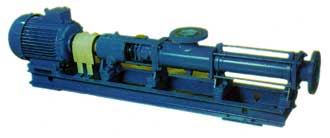
| |||
APPLICATIONThe N1V-type pumps belong to the group of positive-displacement pumps and are designed for pumping pure and polluted liquids with temperatures to 353°K (80°C), including chemically active ones, with viscosity to 46x103 mm2/sec (0,046 m2/sec) and containing solid impurities of 0,2 mm or less in size and 3% to 5% by volume. The N1V-type pumps can deliver as much as 40 m3/h and ensure a delivery pressure of 1kg/cm2.The shaft is gland-sealed or end-sealed. The main parts are made: - the body - of 12X18N9TL(K) or 10X17N13M3T(E) steel; - the yoke - of rubber. The pumps are used in coal industry for removal of water from sumps and water-collectors when driving workings, cutting of slopes and inclined run-offs of mines, as well as in various construction operations. They can also be used in agriculture and other branches of industry. DESCRIPTIONA helical rotor pump has two parts: the flow-type and the driving parts (see the picture below)The flowing part consists of a yoke 4, helix 5, stub tube 1, and casing 6. The driving part consists of a bracket 8, sealing and shafts - driving ones 19 and 9, and cardan shaft 21. The yoke consists of a pipe and a special-shape rubber part that is welded to the pipe by vulcanization. The stub tube has a flange for connection to the pipeline and a cylindrical recess for connection with the yoke. The body is a welded construction of a pipe and two flanges that have cylindrical recesses for coupling with the yoke and the bracket; there is also a flange for connecting up the pipeline. The driving shaft rotates in two radial-thrust bearings 17; a nut 12 controls axial clearance in them. The bearings are installed on the bracket. The driving shaft has seal of soft stuffing D or end face seals G and V. The G type of end seals is used only in N1B 1.6/5 pumps. The sealing type should be specified when ordering. By default, pumps are supplied with soft stuffing kind of seal. The driving shaft consists of two shafts that are joined together by a pin 18. The driving shaft and the helix are connected with each other by a cardan joint 21 that ensures the planetary rotation of the helix necessary for the pumping process. The cardan shaft is joined to the helix on one end and to the driving shaft on the other by pins 23. To enhance the maintainability of the cardan joint, the cardan pins are installed in bushings 22. |
| | | HOME | | | PRODUCTS | | | SITE MAP | | | HOW TO FIND US | | |
